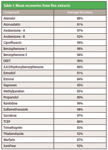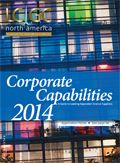One-Step Extraction and Concentration for Identifying Pharmaceuticals and Personal Care Products in Water, Biosolids, and Solids
Over the last decade the use of pharmaceuticals and personal care products (PPCPs) has doubled in the United States.
Over the last decade the use of pharmaceuticals and personal care products (PPCPs) has doubled in the United States. As a result, PPCPs have entered the environment through both human activity and as by-products from manufacturing, agricultural activities, medical use and veterinarian facilities. PPCPs are usually introduced into the environment through the disposal of unused medications into sewer systems and trash. PPCPs tend to be water soluble and do not evaporate under normal temperatures, which is why they end up in soil and water. The full effects of PPCPs on the environment are not fully understood and there is concern about the potential threat they pose to the food chain. Because of the high solubility of most PPCPs, aquatic organisms are most vulnerable. The classes of pharmaceuticals found in these organisms have been linked to slow growth in frogs and the increased feminization of exposed fish. The scope of human exposure to PPCPs from the environment is complicated and increased monitoring is occurring to determine the effect on humans of long-term, low-level exposure to PPCPs.
Due to their persistent nature and toxicity, monitoring water sources for PPCPs is a growing priority for both government agencies and consumers. The following procedure outlines the fully automated, sample-to-vial extraction and concentration of water matrices for the detection of these compounds in one rapid and efficient process.

Table I: Mean recoveries from five extracts
Instrumentation and Consumables
FMS, Inc. PowerPrep™ SPE system (Solid Phase Extraction)
FMS, Inc. PowerVap™ Concentrator
FMS, Direct-to-Vial concentrator tubes
1 g Waters Oasis™ HLB cartridge
UPLC, LC–MS
Procedure: Sample Prep Extraction and Concentration
PowerPrep SPE- for conditioning, sample loading and elution of the extract directly to the concentrator.
PowerVap Direct to Vial Concentrator- for concentrating the extraction to final volume in a vial to be loaded on the LC–MS.
Conclusions
Analysis of the LC–MS data demonstrates excellent recoveries and reproducibility from a traditionally difficult sample matrix. Adding to the efficiency was the use of nitrogen and vacuum to dry the cartridge producing a water free extract that enables a fast concentration step with no loss of analytes. The extract takes 45 min to concentrate using the PowerPrep™ SPE and PowerVap Direct to Vial concentration system when compared to all other drying methods. Using the automated, one step SPE and Direct-to-Vial Concentration tubes from FMS, Inc. eliminates error-prone manual or semi-automated steps from the sample prep process. No sample transfer was necessary, the sample was extracted and automatically sent to the PowerVap Concentrator where the final extract is concentrated directly in a vial for LC–MS analysis. This capability eliminated human error, saved time and increased efficiency while producing reproducible and consistent recoveries.

FMS,Inc.
580 Pleasant Street, Watertown, MA 02472
tel. (617) 393-2396; fax (617) 393-0194
Website: www.fms-inc.com; Email: onlineinfo@fms-inc.com

Separation of Ultra-Short and Long Chain PFAS Compounds Using a Positive Charge Surface Column
December 11th 2024A separation of ultra-short and long chain PFAS (C1-C18) is performed on a HALO®PCS Phenyl-Hexyl column along with a HALO®PFAS Delay column which demonstrates excellent retention for both hydrophilic and hydrophobic analytes.

.png&w=3840&q=75)

.png&w=3840&q=75)



.png&w=3840&q=75)



.png&w=3840&q=75)














